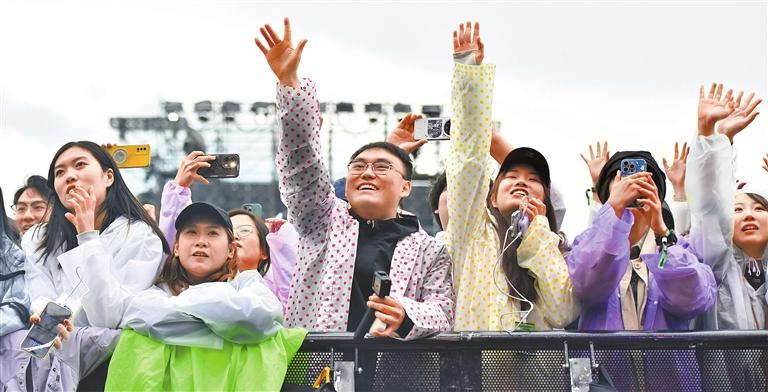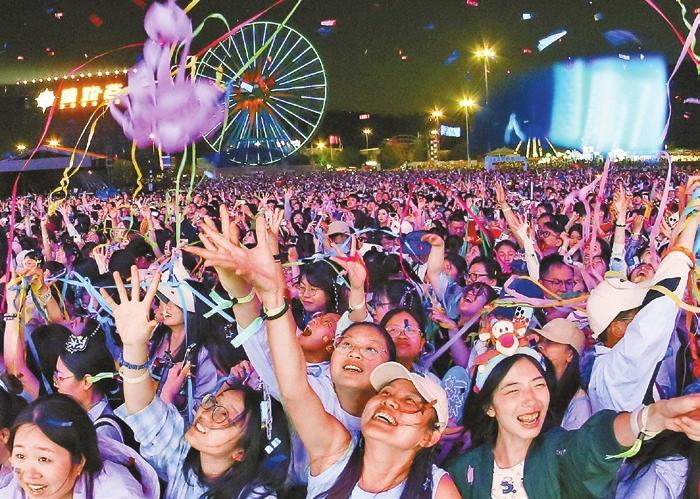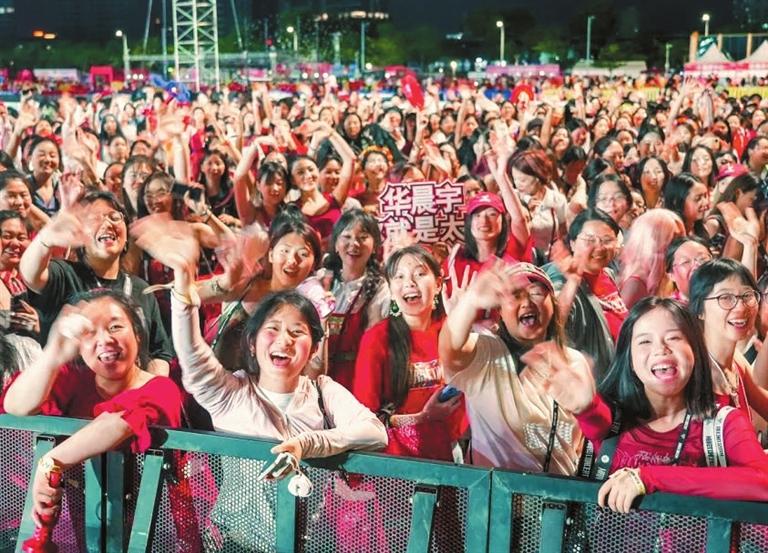




A DIY flower-studded gradient dress, a vast lawn packed with people, the smell of famous local dishes, and the sound waves of a pop concert. Mismatched as they may sound, such are the things that Zhu, a high school student from Guangzhou, was surrounded by at the concert of Chinese pop star Hua Chenyu during the five-day May Day holiday in Foshan, Guangdong Province. “I have never been to such a theme park-style concert, where you can stand, sit, or even lie down to enjoy the event,” she said, also mentioning to the combination of food, drinks, and entertainment. A typical Gen Zer, Zhu spent over 20 hours designing and making her “flower dress” specifically for the concert. Turning concerts into emotion-driven travel experiences during the holiday, her story is far from unique across China. Concert tourism According to tourism platform Meituan Travel, concerts and music festivals have become popular events during this year’s May Day holiday, as more than 100 large-scale commercial performances with over 5,000 attendees were scheduled over the five days nationwide. Combined, these events were projected to draw over 2 million spectators and generate more than 2 billion yuan (US$277.7 million) in hotel and tourism-related spending. Xu Momo, a researcher with tourism platform Tongcheng Travel, said that people born after 1995 now make up 65% of the concert-going population, and just like Zhu, “many of them are not just buying tickets — they’re building rituals.” “From wearing fan-themed outfits and taking themed transport to snapping up fan-colored flowers and checking in at exclusive hotel photo spots, a single concert outing can trigger four to five rounds of social sharing,” Xu said. This pattern of treating concerts as gateways to lifestyle experiences is driving a new paradigm in the platform economy, she said. Guicheng, the district of Foshan hosting the Hua Chenyu concert, was well aware of the chain effect. Two weeks before the event, a regional subway line linking the venue was covered with colorful elements related to the superstar, drawing a daily average of over 25,000 passengers from various regions. Also in South China, hotel bookings in Haikou, capital of Hainan Province, during the May Day holiday increased by 3.4 times year on year, the highest growth among major tourist cities of the country, according to data from travel platform Qunar. The surge was largely driven by a concert featuring the popular boy band Teens in Times (TNT) during the holiday. Li Yangran, general manager of a 182-room resort hotel in Haikou, felt it firsthand, saying that the property’s occupancy rate remained at over 90% from May 1 to 4, and nearly 60% of the guests stayed for the concert, most of whom were born in the 1990s and 2000s. To ride the trend, local authorities had encouraged businesses to roll out special offers. Diversified destinations Apart from concert economy, China’s Gen Z population is also reshaping the tourism landscape by favoring lesser-known destinations over traditional hotspots. Qiao Yan, a 25-year-old office worker in Beijing, chose to spend this year’s May Day holiday in the coastal city of Rizhao in East China’s Shandong Province — not usually among the hottest tourist spots — and opted for a more relaxed approach. Upon checking in at her guesthouse, she walked to a nearby seafood restaurant, ordered a local seafood platter, and enjoyed her meal while taking in the ocean view through the window. During the following days, besides meals, she planned to spend her afternoons basking in the sun on the beach, daydreaming or just relaxing in nearby cafes. “In the past, my travel plans were always packed, and by the end of the day, I would feel even more exhausted than when I was working,” she said. “This time, I just wanted to take it easy and enjoy the local food and a slower pace of life.” Qiao is not alone in embracing this new style of leisure travel. According to data from Mafengwo, a popular Chinese travel platform, avoiding crowds was a major priority for young travelers during this year’s May Day holiday. Searches and interest in “less crowded, off-the-beaten-path destinations for May Day” surged by 200% over the past month. According to data from Trip.com, tourism orders in county-level markets during the holiday surged by 36% year on year, far surpassing the growth seen in major first and second-tier cities. Hotel bookings in smaller cities such as Anji, Yanji, and Dujiangyan also jumped by 64%, while ticket sales for attractions soared by over 200%. Homestay platform Muniao also reported a 126% year on year increase in county-level tourism orders as of late April. Many counties have subsequently emerged as hot spots for the holiday, including Pingtan and Xiapu of Fujian, Changli and Lingshui of Hainan, as well as Luanchuan and Zhongmu of Henan. The outbound travel industry is also experiencing shifts brought by Gen Z, which has become a rapidly growing driving force. Yang Jinsong, a senior researcher with the China Tourism Academy, said that outbound travel destinations are diversifying, with more varied and diverse destination choices emerging, indicating that the recovery of China’s outbound travel market is not just a rebound in scale but also a sign of changing consumer preferences. The shift was also present in how Gen Z decided on travel-related issues. In many travel livestreams, more and more young people from this generation are making decisions based on both immersive experiences and real-time interaction. Pan Bo, vice president of the HCG International Travel Group, noted that Gen Z draws inspiration from places like the video platform Bilibili and lifestyle social media platform RedNote and attaches great importance to the “experience-sharing” loop. Trip companions Gen Z’s demand for greater emotional value has also driven them to actively seek better companionship during their trips, which his possible today thanks to the highly developed social media. One of them is Chen Duoduo, a Gen Z college student based in east China’s Nanjing, who plans to hire a “local companion” to take some good pictures of her during her upcoming trip. According to Chen, the cost can be covered by the income from her part-time job as a “local companion,” from which she earned about 1,000 yuan during the three-day Qingming Festival holiday in early April. On RedNote, one of the most popular social media platforms among Gen Z, the tag “local companion” has garnered over 63.43 million views and 1.05 million comments as of May 4. Jiaying, a Shanghai native in her 20s, started her local companion business in March, providing makeup, photoshoots, photo editing, and itinerary planning. She has received over 30 orders through social media and other online platforms. Most of her clients are also young people aged between 20 and 35, especially visiting females looking for a “temporary bestie” to take photos with, go shopping with, and enjoy good food together. “I feel like I can learn a lot from other people’s experiences. Their life stories become part of my own, and at the same time, I become part of theirs,” she said. Zhang Chunlong, a senior researcher on social policies at the Jiangsu Provincial Academy of Social Sciences, believes that today’s young people, facing mounting pressure from work and life, place greater value on emotional connection. The growing pursuit of emotional resonance has created vast market potential for what he calls the companionship economy. (Xinhua) | 
